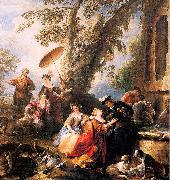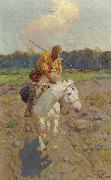Wholesale Oil Painting Reproductions No Minimum and Door to Door! |
|||||||||||
|
|
|||||||||||

|
|||||||||||
|
|
|
||||||||
All Parrocel, Joseph Oil Paintings |
||||||||
|
|
||||||||
|
|
||||||||
|
Artist Introduction: French, 1646-1704
He studied with his father Barthelemy Parrocel (1595-1660) and then with his elder brother Louis Parrocel (1634-94). He went to Paris for four years to perfect his work and then, c. 1667, to Rome, where he became the pupil of the battle painter Jacques Courtois and was influenced by Salvator Rosa. He remained in Italy for eight years and stayed for a time in Venice, before returning to settle in Paris in 1675. He was approved (agree) by the Academie Royale de Peinture et de Sculpture in February 1676 and received as a full member in November of the same year, presenting the Siege of Maastricht (Draguignan, Mus. Mun.). His painted oeuvre consists principally of military scenes, particularly battles, and he received numerous royal commissions. In the period 1685-8 he executed 11 paintings for the Salle du Grand Couvert at the cheteau of Versailles (nine in situ; one in Tours, Mus. B.-A.; one in Dijon, Mus. B.-A.); in 1699 he painted the Crossing of the Rhine (Paris, Louvre.) for the cheteau of Marly, Yvelines, and in 1700 he executed the Fair at Bezons (Tours, Mus. B.-A.), anticipating the fetes galantes of Antoine Watteau. He was also the author of a number of hunting scenes . His most important religious paintings were the May of Notre-Dame de Paris of 1694, St John the Baptist Preaching (Arras, Mus. B.-A.) and St Augustin Succouring the Sick (c. 1703; Nantes, Mus. B.-A.), which was intended for the monastery in the Place des Victoires in Paris. He also contributed battle scenes to the backgrounds of portraits by Hyacinthe Rigaud and by Gabriel Blanchard. His technique was highly original in the context of his time; he employed a very free style of execution and used thick impasto and intense colours. He was also a prolific engraver, producing around 100 plates, |
||||||||
|
|
||||||||
|
The Return from the Hunt Painting ID:: 19766 |
1700
Oil on canvas
National Gallery, London. |
|||||||
Height Width |
INS/CM Quality |
|||||||
|
X |
| |||||||
|
|
||||||||
All Franz Roubaud Oil Paintings |
||||||||
|
|
||||||||
|
|
||||||||
|
Artist Introduction: was a Russian painter who created some of the largest and best known panoramic paintings.
Roubaud was born on 15 June 1856 in Odessa and attended an art school there. In 1877 he went to Munich, where he studied at the Munich Academy. He then settled in Saint Petersburg, working in the Imperial Academy of Arts and painting huge panorams of historical battles - Storm of Achulgo (1896, Tiflis, now under the restoration in the museun of graphic arts in Makhachkala), Siege of Sevastopol (1854) (unveiled in 1905, damaged during the Siege of Sevastopol (1942), restored in the 1950s), Battle of Borodino (1911, moved to Poklonnaya Hill in Moscow in 1962) and the Russo-Persian War (1804-1813). His works were so large that they had to be exhibited in pavilions specially built for that purpose. In 1913, Roubaud left Russia for Munich, where he died on 13 March 1928.
|
||||||||
|
|
||||||||
|
|
The Return from the Hunt Painting ID:: 97893 |
oil on canvas
Dimensions 62.2 x 39.3 cm
cyf |
||||||
Height Width |
INS/CM Quality |
|||||||
|
X |
| |||||||
|
|
||||||||
|
Prev Next
|
||||||||
|
|
||||||||
|
Related Paintings to Franz Roubaud :. |
||||||||
|
|
||||||||
|
CONTACT US |


